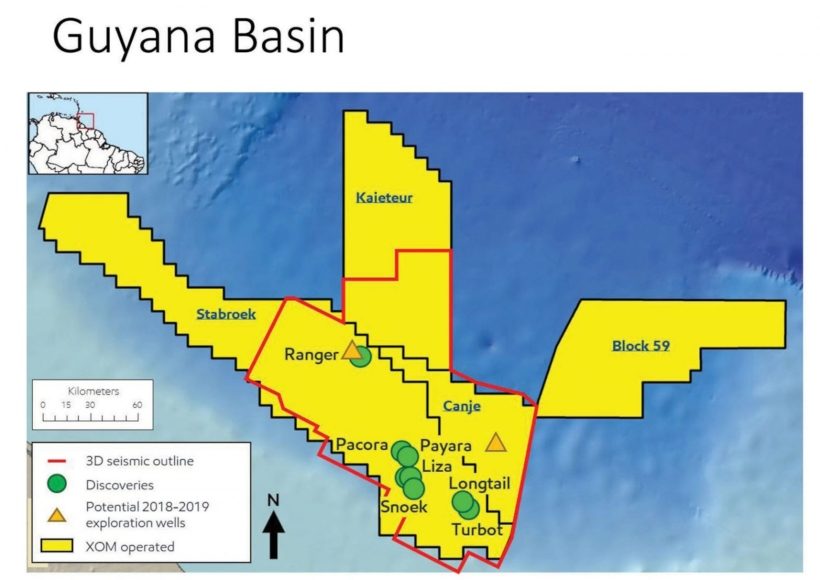ExxonMobil’s subsidiary, Esso Exploration, and Production Guyana Limited (EEPGL), will be conducting 3D and 4D seismic surveys within the south-eastern portion of the Stabroek Block, covering the Turbot and Payara areas.
The Turbot area has produced five discoveries since it was first drilled in October 2017. The discoveries include Turbot-1, Tilapia-1, Longtail, Pluma, and Yellow Tail-1.
Turbot-1 was ExxonMobil’s first oil discovery on the Stabroek Block and was drilled in a new reservoir, encountering approximately 75 feet (23 meters) of high-quality, oil-bearing sandstone reservoir.
As for the Longtail, this well encountered approximately 256 feet (78 meters) of high-quality, oil-bearing sandstone reservoir. It was safely drilled to a depth of 18,057 feet (5,504 meters) in 6,365 feet (1,940 meters) of water. The Stena Carron drillship commenced drilling on May 25, 2018 and the discovery was made on June 20, 2019.
With regard to the Pluma-1 well, Exxon said that it found 121 feet (37 meters) of oil-bearing sandstone, on trend with other discoveries in Guyana’s Cretaceous sandstone play. The discovery, along with appraisals, adds one billion barrels of oil equivalent (boe) of discovered resources.
Tilapia-1 is the fourth discovery in the Turbot area and it encountered approximately 305 feet (93 meters) of high-quality oil-bearing sandstone reservoir.
The Yellowtail-1 represents the fifth discovery in the Turbot area and is located approximately six miles (10 kilometres) northwest of the Tilapia discovery. It encountered approximately 292 feet (89 metres) of high-quality [oil] bearing sandstone reservoir and was drilled to a depth of 18,445 feet (5,622 metres) in 6,046 feet (1,843 metres) of water.
Meanwhile, the Payara discovery was announced in July 2017. It encountered 59 feet (18 meters) of high-quality, oil-bearing sandstone reservoirs. ExxonMobil is awaiting approval from the relevant authorities to move ahead with its development plans for this area.
According to the Maritime Administration Department (MARAD), the surveys for the aforementioned areas will conclude on June 30 and will incorporate the use of four vessels. They are the RV Ramform Tethys, the MV Thor Magni, the MV Delta Monarch, and the MV Miss Megan.
Last year December, the Ramform Tethys, which was contracted by Exxon to conduct 3D seismic survey on the Stabroek block, was intercepted by the Venezuelan navy. The vessel, which is owned by Norwegian seismic services provider PGS, had a total of seventy crew members on board, including the captain.











